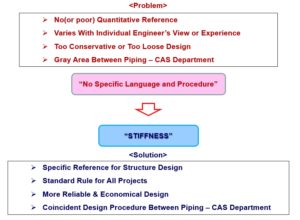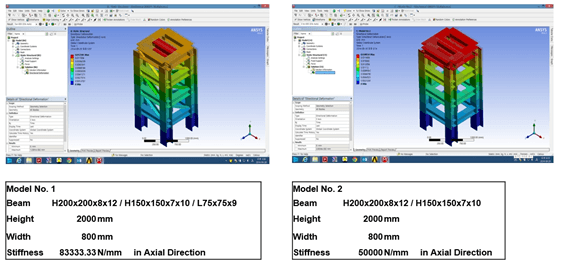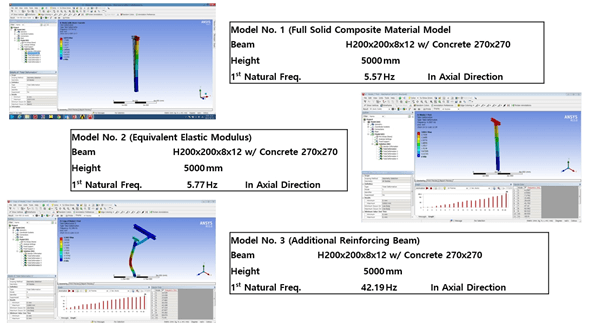Reciprocating machinery (i.e. reciprocating compressors, pumps) is a common source of piping vibration and fatigue failure. Pressure pulsations due to flow modulations generated from the cylinder crank mechanism propagate through piping in the form of harmonic excitation. These pulsations create acoustic resonance in the piping when the natural frequency of the piping system and its supporting structures coincides with some pulsation frequencies (e.g. 1x, 2x compressor running speed). Piping vibration occurs when the acoustic resonance amplifies the pulsation. Therefore, the goal of a piping vibration study is to determine an appropriate design that avoids acoustic resonance within the piping system.
In engineering projects, however, a piping system design that eliminates acoustic resonance are rarely achievable due to the following limitations.
-
- A detail design instruction for piping support / supporting structure design is not provided.
- Piping support / supporting structure are not actually modeled in the vibration simulation model.
- The study report is issued at later stage of engineering (e.g. after 60% / 90% model review).
The supporting structure stiffness, which is a critical factor of the structural design, is often missing in the piping vibration report. Many analyses are simply provided with a requirement for support and the direction of restraint. This leaves the detailed design of supporting structure as a gray area, and consequently many supporting structures are “weak”, causing insufficient stiffness of the piping system.
The piping vibration study is often performed assuming the pipe support and supporting structure are rigid. This provides a less conservative result which leads to easy analysis for the engineer, but this can produce a very unsafe piping support and supporting structure design in the actual piping system.
A pulsation vibration study can take three to nine months to complete, as it is normally performed by specialized 3rd party agents. The final piping vibration report is often issued at a later stage of the project, potentially causing a large number of design changes and impacting project schedule.
To mitigate and overcome those common issues, a more proactive piping support and structural design procedure should be established and executed.
The following diagram summarizes the typical problem encounter in anti-vibration piping and structural design, and suggests a solution to improve this issue.

Establishing corporate and/or project standard procedures for piping supports and supporting structures in the language of “stiffness” is a good way to achieve sound design at an earlier stage of a project. In many projects, piping engineers did not have any guidelines to provide to the structural engineers – except for loading data based on rough assumptions or static stress analysis results. Consequently, the structural engineers design their structures without any detailed consideration of designing the structure to resist piping vibration.
However, if piping engineers provided the required stiffness values for each support location to structural engineers, a more reliable structural design would be achieved, and there will be few design changes after completion of pulsation vibration study.
A standard procedure for establishing piping support and supporting structural stiffness can be achieved in several ways. The followings are examples of suggested approaches.
- Collect piping support and structural design examples from previous project cases
- Calculate and apply the required support stiffness to meet the system natural frequency guideline of API STD 618
- Calculate and apply the required support stiffness to meet the piping vibration guideline of API STD 618
- Perform experimental study of piping support and structural design examples utilizing finite element analysis (FEA) technology
The examples shown below provide an idea of piping support and supporting structure design optimization using FEA.
<Supporting Structure Optimization Study – Stiffness Domain>

<Supporting Structure Optimization Study – Natural Frequency Domain>

Please contact [email protected] for more detailed information on this subject. Northern Crescent team is capable of the following services to support you:
- Develop Standard Work Procedure for Anti-Vibration Piping System Design
- Perform Static Piping Flexibility Analysis
- Perform Dynamic Piping Flexibility Analysis
- Perform Piping Vibration Analysis
- Perform Pipe Support Design with FEA Technology
- Perform Structural Support Design with FEA Technology
- Supervise Field Trouble Shooting
